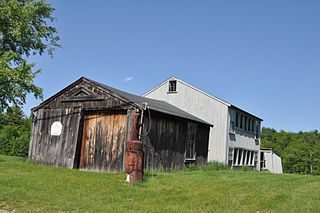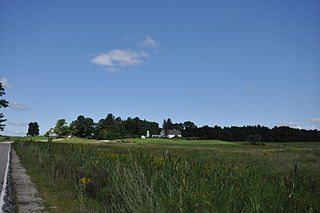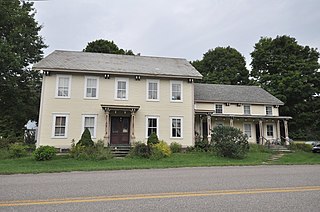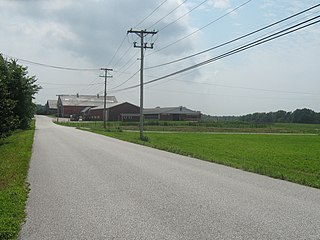
The New Hampshire Farm Museum is a farm museum on White Mountain Highway in Milton, New Hampshire, United States. Three centuries of New Hampshire rural life are presented in the historic farmhouse. The museum includes a 104-foot-long (32 m) three-story great barn with collection of agricultural machinery, farm tools, sleighs and wagons. There are also live farm animals, a nature trail and a museum shop. The museum is located on the former Plumer-Jones Farm, a traditional series of connected buildings with farmhouse dating to the late 18th century and barns dating to the mid 19th century, which was listed on the National Register of Historic Places in 1979.

Ross Farm is a historic farmhouse at 123 Meadow Street in Northampton, Massachusetts. Its importance rests in its significance as the site of a utopian community that operated there from 1841 to 1845, and for its use as a site on the Underground Railroad. Once part of a 300-acre (120 ha) parcel, the property has been reduced to 2.25 acres (0.91 ha), whose only significant structure is the farmhouse which was built in 1825.

Greenmead Historical Park, also known as Greenmead Farms, is a 3.2-acre (1.3 ha) historic park located at 38125 Base Line Rd., Livonia, Michigan. It includes the 1841 Greek Revival Simmons House, six other structures contributing to the historic nature of the property, and additional buildings moved from other locations. Greenmead Farms was designated a Michigan State Historic Site in 1971 and listed on the National Register of Historic Places in 1972.

Lamson Farm is a historic farm property on Lamson Road in Mont Vernon, New Hampshire. Founded in the 1770s and operated as a farm until 1975, it is one of the few surviving intact 19th-century farm properties in the community. Its land, over 300 acres (120 ha) in size, is now town-owned conservation and farmland. The property has trails open to the public, and an annual celebration of Lamson Farm Day is held here every September. The property was added to the National Register of Historic Places in 1981.

The Lawrence Farm is a historic farm at 9 Lawrence Road in Troy, New Hampshire. Established in the early 19th century, the property has been in continuous ownership by the same family since then. Its farmstead, including a c. 1806 farmhouse, exemplifies the changing trends in domestic agricultural practices of the 19th and 20th centuries. The farm was listed on the National Register of Historic Places in 2000.

Spring Hill Farm is a historic farm at 263 Meriden Road in Lebanon, New Hampshire. Founded in the late 18th century, the farm is noted for innovations in dairy farming practices introduced in the 1920s by Maurice Downs. It is also one of a small number of surviving farm properties in the town, and was listed on the National Register of Historic Places in 2002.

Beede Farm is a historic farm and summer estate at 178 Mill Bridge Road in Sandwich, New Hampshire. The property includes a c. 1830s farmhouse that was erected by John Beede, whose uncle, Daniel Beede, was responsible for platting out much of Sandwich. The 303-acre (123 ha) includes a family cemetery. It was transformed into a summer estate in 1938. The farm was listed on the National Register of Historic Places in 2012.

Elm Farm, alsk known as the Sargent Farm, is a historic farm property at 599 Main Street in Danville, New Hampshire. Established about 1835, it has been in agricultural use since then, with many of its owners also engaged in small commercial or industrial pursuits on the side. The main farmhouse is one of the town's best examples of Gothic Revival architecture. The property was listed on the National Register of Historic Places in 1988.

The Jenness Farm is a historic farm property at 626 Pickering Road in Rochester, New Hampshire. It consists of about 190 acres (77 ha) in Rochester and adjacent Dover, and has been in continuous ownership by the Jenness family since 1837. It was, at the time of its 2001 listing on the National Register of Historic Places, one of just ten farms in the city with intact land and buildings.

Park Farm is a historic farm property at 26 Woodchuck Hill Road in Grafton, Vermont. With a farmhouse dating to about 1820, and most of its outbuildings to the 19th century, the farm remains an excellent example of a typical 19th-century Vermont farmstead. The property was listed on the National Register of Historic Places in 2003.

Top Acres Farm, known historically as the Fletcher–Fullerton Farm, is a farm property at 1390 Fletcher Schoolhouse Road in Woodstock, Vermont. Developed as a farm in the early 19th century, it was in continuous agricultural use by just two families for nearly two centuries. It was listed on the National Register of Historic Places in 2004.

Field Farm is a historic farm property on Fuller Mountain Road in Ferrisburgh, Vermont. Developed around the turn of the 19th century, the property includes an early farmhouse and barn, as well as outbuildings representative of Vermont's trends in agriculture over two centuries. The property was listed on the National Register of Historic Places in 1995.
Fenn Farm is a historic property on Case Street in Middlebury, Vermont. Developed c. 1828 as a sheep farm but now diversified, it now includes a well-preserved collection of mid-19th century farm buildings. It was listed on the National Register of Historic Places in 1995.

The Martin M. Bates Farmstead is a historic farm property on Huntington Road in Richmond, Vermont. Farmed since the 1790s, the property is now a well-preserved example of a mid-19th century dairy farm, with a fine Italianate farmhouse. The property was listed on the National Register of Historic Places in 1991.

The Ballard Farm is a historic farm property on Ballard Road in Georgia, Vermont. At the time of its listing on the National Register of Historic Places in 1993, it had been under cultivation by members of the Ballard family for more than 200 years, having been established in 1788 by a sale from Ira Allen to Joseph Ballard.

Gray Rocks is a historic farm property on United States Route 2 in Richmond, Vermont. Developed in the early 19th century, it was in agricultural use until 1978, and has a well-preserved set of farm buildings dating from c. 1813 to the early 20th century. It was listed on the National Register of Historic Places in 1996.
The Dan Johnson Farmstead is a historic farm property on United States Route 2 in Williston, Vermont. It was first developed in 1787 by Dan Johnson, one of Williston's first settlers, and has remained in his family since that time. The property includes three 19th-century houses and a large barn complex, as well as more than 200 acres (81 ha) of land crossed by US 2 and Interstate 89. It was listed on the National Register of Historic Places in 1993.

The Murray–Isham Farm, or more recently just the Isham Family Farm, is a historic farm property at 3515 Oak Hill Road in Williston, Vermont. The farm has been in active use since about 1850, most of them by the Isham family. The farmstead includes a c. 1850 Gothic Revival house and farm buildings of similar vintage. It was listed on the National Register of Historic Places in 1992, and is the subject of a conservation easement preserving its agricultural character.

Lee Farm is a historic farm property on Vermont Route 18 in Waterford, Vermont. Established in 1801, it was for many years worked by members of the Lee family, and part of a thriving rural community called Waterford Hollow. Its farmstead features surviving 19th and early 20th-century outbuildings and a high-quality Greek Revival farmhouse. A 5-acre (2.0 ha) portion of the farm, encompassing the farmstead, was listed on the National Register of Historic Places in 1983.
The Luce Farm is a historic farm property at 170 Luce Drive in Stockbridge, Vermont. The farm was established in the late 18th century, and is a well-preserved example of a rural agriculturally diversified farm property. It was listed on the National Register of Historic Places in 2021.





















